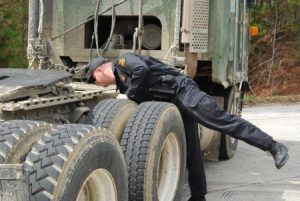Roadside Inspections Are Serious….Be Prepared
 Roadside inspections can occur practically anywhere. With advances in technology and procedures, roadside inspections are no longer limited to being conducted at permanent facilities along our highways and can now be conducted virtually anywhere. The main purpose for these inspections it to give the commercial vehicle and its driver an on-the-spot check-up to keep the driver and others on the road safe.
Roadside inspections can occur practically anywhere. With advances in technology and procedures, roadside inspections are no longer limited to being conducted at permanent facilities along our highways and can now be conducted virtually anywhere. The main purpose for these inspections it to give the commercial vehicle and its driver an on-the-spot check-up to keep the driver and others on the road safe.
During 2011 over 70,000 roadside inspections were conducted. Out of these 70,000 vehicle inspections, 18.3% were placed out of service for mechanical problems. The driver out of service rate was 4%. This means that nearly 13,000 vehicles and nearly 3,000 drivers were placed out of service. Once a vehicle or driver has been placed “out-of-service”, they are no longer able to continue working until the problem or issue is repaired. Be sure all our vehicles have proper documentation, inspection books and all mechanical repairs are complete.
There are currently 6 levels of roadside inspections:
- Level 1– Examination of drivers documents and detailed vehicle inspection.
- Level 2– Walk-around driver/vehicle inspection. Includes document inspection and inspection of items that can be seen without getting under the vehicle.
- Level 3– Driver only inspection. Involves checking documents and items only related to the driver.
- Level 4– These are special inspections. Example- Checking a vehicles brakes.
- Level 5– This is a vehicle only inspection and is conducted without the driver present.
- Level 6– Inspection for radioactive shipments.
The CSA (Comprehensive Safety Analysis) is an enforcement initiative that scores carriers and drivers on seven Behavior Analysis Safety Improvement Categories (BASIC).
The seven basics are:
- Unsafe Driving: Refers to dangerous or careless operation of commercial motor vehicles.
- Fatigued Driving: Refers to driving a commercial motor vehicle while fatigued.
- Driver Fitness: Refers to drivers who are unfit to operate a Commercial Motor Vehicle due to lack of training, experience, or medical qualification.
- Controlled Substances and Alcohol: Refers to drivers who operate a Commercial Motor vehicle under the influence of drugs and alcohol.
- Vehicle Maintenance: failure due to improper or inadequate maintenance.
- Cargo Related: Shifting loads, spilled or dropped cargo, and unsafe handling of hazardous materials.
- Crash Indicator: Histories or patterns of high crash involvement, including frequency and severity.
Visit Tracey Road Equipment for all your Truck and Equipment needs.
